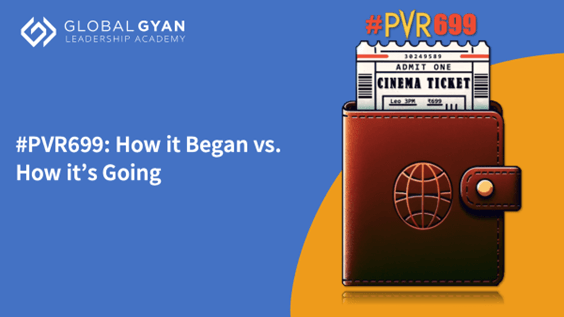What happened to PVR’s 699 Pocket Strategy?


On October 14, 2023, PVR INOX, India’s leading cinema chain, launched a rather interesting scheme – watch 10 movies in a month at ₹699/- only. Yes, you read that right—₹699—even a standard ticket would cost more than that at PVR!
Touted as the country’s first subscription-based service, the “PVR Passport” was designed to be a monthly subscription pass with the following caveats:
- It can be used from Monday to Thursday.
- It cannot be used to avail of premium services like IMAX, Gold, LUXE and Director’s Cut.
Fair enough, perhaps this was PVR’s way to resuscitate the cinema business, which was leapfrogging its way back to the top at the time with back-to-back blockbusters like Pathaan, Jawan & Leo.
In this article, we will cover:
What’s in it for PVR?
On October 16, 2023, PVR Cinema posted a message on X (formerly Twitter):
“We at PVR INOX feel, that movie lovers of India deserve the freedom to watch every movie. Yes, this was easier said than done, but we have made it happen, only for you, because for us, your choice, your freedom, your opinion matters.”
We could argue that PVR possibly saw some benefits in announcing this plan:
- Unutilised Capacity on Weekdays – Indian films make maximum profits during the first weekend of release. Following this 3-day window, i.e. Friday (release day), Saturday (second day) and Sunday (third day), the sales plummet, until they begin to stabilise in the following weeks. In essence, Monday through Thursdays are dry days. While there are some takers for seats, they hardly compare to the weekend crowd. PVR found a gaping hole here and targeted college-going students, homemakers and senior citizens.
- Threat and disruption from OTT – Netflix, Hotstar and Amazon Prime Video were among the many OTT platforms that kept the frustrated audience entertained. Post lockdown, when theatres reopened to the general public, a harsh reality struck them: not only were the audiences weary of theatres but they were also content with the OTT offerings. The phrase “I’ll wait for the movie to release on OTT” caught on, much to the chagrin of the leading cinema chains. Again, PVR saw an opportunity to compete with these platforms by subsidising ticket rates (through this plan), where OTT platforms began inflating theirs.
- Innovation/Exploring New Business Models – The essence of any successful business or brand is continuous innovation. Reinvention is the name of the game that star players play. One cannot underestimate the importance of the first-mover advantage, and here’s where PVR hoped to strike gold with the passport scheme; and it did, briefly (we’ll spill the beans in a bit).
- Explore Recurring Revenue Channels – Revenues and profits are the heart and soul of a business. And thus, businesses need to keep exploring novel ways of generating revenues as the market landscape and customer needs change. However, a surefire way of maintaining consistent flow of income is through recurring revenues—for multiplexes, this is achieved by filling out the morning & afternoon shows, typically reserved for mid-to-lower budget movies. PVR identified the vulnerability and converted it into an opportunity.
After some time, you will create this habit of consumers coming back to the cinema. So it’s really a momentum shifter, not just a price promotion.
What’s in it for the Audience?
With OTT platforms on the rise, it’s no secret that theatres are entering the “redundant” territory. Every other day, we are bombarded with the news of streaming services entering the market, including one from our very own King Khan, so much so that users are now spoiled for choice!
When PVR introduced PVR699, the Indian audience immediately asked, “what’s in it for us”? Spoiler alert: not all that much.
Here are the upsides and downsides of the PVR Passport:
The positive(s):
- Subsidised Costs: PVR was smart enough to pivot to an audience that didn’t have much income to work with in the first place. Students, homemakers and senior citizens could appreciate a good discount when they saw one. Moreover, with the price of tickets (and the accompanying “moviegoing experience”, with food and chips, and so on) shooting for the stars, it is no wonder that even the masses would gravitate towards subsidised plans. In a way, this plan tackled the threat of time and cost together.
The negatives:
- Supply vs. Demand: While there may be supply of movies, it begs the question, “Do we have 10 movies in a month that are worth watching”? Any target audience would ask this before signing up for such a scheme. While 2023 was generally seen as a year of Bollywood revival thanks to the pan-India movie releases, we can still count the blockbusters on our fingers. Moreover, films that necessitate a “cinematic experience” are few and far in between.
- Cultural Distortion: Traditionally, Indians are movie buffs. But are we as besotted with the cinemas as to watch 2-3 movies in the theatre every single month? Movie marathons are a luxury in a developing country like India, where a majority of the populace cannot afford them. So, whom does this plan actually benefit and to what extent?
- Value for Money: Indians always look at value for money, even in something as simple as buying a pack of chips. So, when the PVR Passport came with a three-month lock-in period, tails started wagging and people began doing some math. Let’s make a detour and look at Zomato, to make our case. With Zomato Gold, users get discounts ranging from 15% to 30% at restaurants. They take a stand – “if my actual savings is more than the investment in the subscription, I am happy”. In the case of PVR699, a subscriber’s minimum investment was ₹699 for 3 months (counting the lock-in period), equating to ₹2,100. Thus, PVR needed to convince users to cough up at least that much in order to subscribe. Since they could watch 10 movies for ₹2,100, they should be saving ₹210 per ticket; but how realistic is this, given that ticket prices are lower on weekdays anyway? What margins are users working with?
Where’s #PVR699 Today?
PVR awarded the passport to the first 20,000 subscribers ONLY in the first instalment.
Why? Our best guess is the theatre chain wanted to test waters before expanding the program.
And guess what? Despite the glaring negatives for the audience, round one was received positively. “It achieved the milestone of completion of sale [of 20,000 subscriptions] within few weeks of its launch, witnessing an extraordinary success in the cinema industry,” Gautam Dutta revealed in a recent interview.
A confounding paradox, isn’t it?
PVR discontinued the plan thereafter, opening the gates for massive criticism on social media – especially from cinemagoers down south, who were dejected that the passport wasn’t made available to them in the first place.
In response, PVR announced a second round of passport rollouts, offering 5x more subscriptions!
Pre-registrations are currently underway for Passport 2.0, and here’s the good news – they’re selling out like hotcakes! This time around, PVR has extended the invitation to several cities in the South, including Hyderabad, Chennai and Bangalore, prompting pre-registrations to exceed the “initially planned number of passports to be issued”.
Has PVR really struck gold with this innovative scheme?
Our Verdict
Conceptually, PVR699 is a good idea to utilise empty capacity. However, a few tweaks may make it more attractive to the end user:
- Amend the single-user stipulation. Majority of the cinephiles don’t go to the cinemas alone, least of all PVR699’s target audience, i.e. students, homemakers and senior citizens. One of the ways to optimise the plan is to allow the subscriber to buy 2 tickets or get the second ticket at a substantial discount.
- Trial a few new scheme design It may well be the case that cinemagoers won’t actually be able to consume 10 movies in a month, because the entertainment industry may not churn out 10 ‘must watch’, or even compelling enough, movies every month. It would be wise for PVR to trial new designs with this deal, perhaps add a complementary meal or a night show or even access to special screenings to make the overall package more attractive.
- Expand the content catalogue to include older/off-beat movies, documentaries, re-releases and/or global films that may not be available otherwise.
These modifications can help to address PVR’s main motivation for introducing the plan in the first place viz. generating recurring revenue streams and utilising business downtimes. For PVR, the end goal should be to think about the long haul and not intermediate success. That said, let’s wait to see how round 2 fares, shall we?
Let us know what you think about the present and future of the #PVR699 plan in the comments section below.






Responses